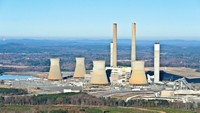Advertisement
Grab your lab coat. Let's get started
Welcome!
Welcome!
Create an account below to get 6 C&EN articles per month, receive newsletters and more - all free.
It seems this is your first time logging in online. Please enter the following information to continue.
As an ACS member you automatically get access to this site. All we need is few more details to create your reading experience.
Not you? Sign in with a different account.
Not you? Sign in with a different account.
ERROR 1
ERROR 1
ERROR 2
ERROR 2
ERROR 2
ERROR 2
ERROR 2
Password and Confirm password must match.
If you have an ACS member number, please enter it here so we can link this account to your membership. (optional)
ERROR 2
ACS values your privacy. By submitting your information, you are gaining access to C&EN and subscribing to our weekly newsletter. We use the information you provide to make your reading experience better, and we will never sell your data to third party members.
Environment
Clearing Skies
Clean Air: EPA rule curbs pollutants from power plants in eastern U.S.
by Cheryl Hogue
July 11, 2011
| A version of this story appeared in
Volume 89, Issue 28

Smog and fine particulate pollution in the eastern half of the U.S. will be slashed under a rule EPA released last week to curb power plant emissions that blow across state lines.
EPA Administrator Lisa P. Jackson says the new rule is “designed to prevent the drift of harmful, airborne pollution from a source in one state to the air people are breathing in communities in another state.” The regulation affects 28 states, mainly in the East and Midwest.
Starting in 2012, power plants in 23 states from Texas to New York must curb emissions of sulfur dioxide, a component of fine particulate pollution. They must also reduce emissions of nitrogen oxides (NOx), which are precursors to ground-level ozone, or smog, and contribute to fine particulate pollution. The rule, along with state actions, will reduce SO2 by 73% and NOx by 54% from 2005 levels by 2014.
Meanwhile, power plants in another five states must reduce NOx during the summer, when ground-level ozone levels are highest.
The new regulation replaces a rule issued under President George W. Bush in 2005. A federal court determined that the Bush regulation violated the Clean Air Act. The court ordered EPA to start from scratch, but allowed the 2005 rule to remain in place as a stopgap.
EPA estimates that by 2014 the rule will yield $120 billion to $280 billion in annual health and environmental benefits. It is projected to cost power plants $800 million a year in operational compliance and the equivalent of $1.6 billion annually for 30 years in investments in pollution control equipment.
The rule is attracting mixed reactions.
S. William Becker, executive director of the National Association of Clean Air Agencies, welcomes the rule but says it falls short of helping downwind states meet the national air quality standards for ozone and particulates.
Sen. James M. Inhofe (R-Okla.), says the rule, along with an upcoming EPA regulation to control mercury from power plants, “could force the retirement of 30 to 100 gigawatts of coal-fired power plants,” raise the price of electricity, and eliminate jobs.




Join the conversation
Contact the reporter
Submit a Letter to the Editor for publication
Engage with us on Twitter